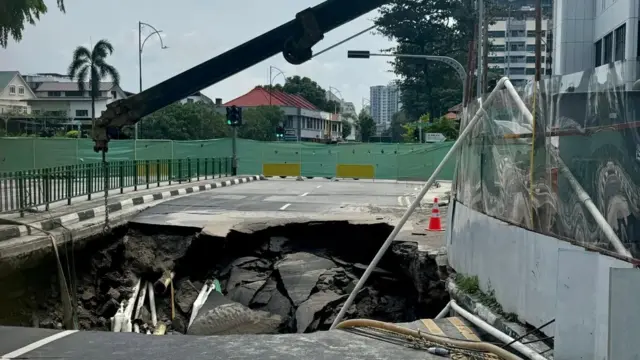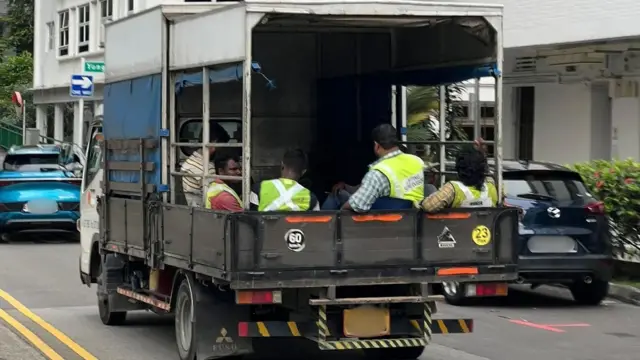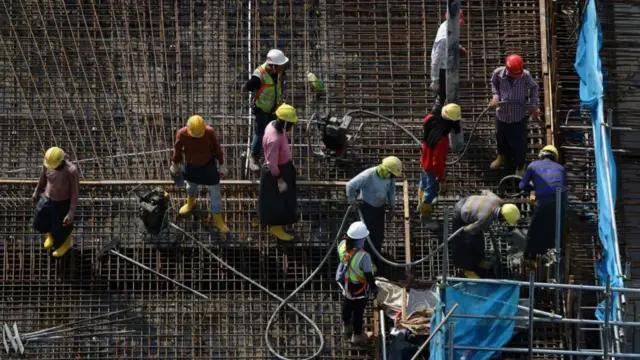Singapore collapse reignites debate over migrant workers' rights
Image source,PUB
image caption:Seven Indian workers used ropes to hoist a woman to safety after her car fell into a sinkhole
- Kelly Ng
- Role,BBC reporter from Singapore
- August 1, 2025
A 3-meter (10-foot) deep sinkhole appeared on a busy road in Singapore on Saturday, engulfing a black Mazda car and prompting a group of workers at a nearby construction site to spring into action.
They grabbed a rope from the construction site, threw it into the sinkhole, and gave it to the female driver who had gotten out of the car.
In less than five minutes, they had her to safety.
“I was scared, but all I wanted was to rescue the woman first,” Suppiah Pitchai Udaiyappan, a construction site foreman, later told reporters.
Video of the accident quickly went viral on social media, with many praising the workers as heroes.
Mr Udayappan is a "guest worker" - a term used in Singapore to describe the 1.17 million migrant workers who have come to this wealthy city from low-income countries such as Bangladesh, India and Myanmar.
The vast majority of them work in low-paying, labour-intensive jobs that Singaporeans are unwilling to do.
This is not the first time that foreign workers have served as first responders in Singapore. In April this year, four of them helped rescue children trapped in a shophouse after a fire.
Their latest action has reignited debate about the rights, or lack thereof, of low-wage workers in Singapore.
Singapore's fast-growing economy is built on the backs of these foreign workers, who make up nearly three-quarters of the country's foreign workforce, many of whom work in industries such as construction, shipbuilding and manufacturing.
While Singapore has no minimum wage, advocacy groups say these workers earn as little as S$300 (US$233; £175) a month and live in crowded dormitories, often far from residential areas.
However, they often face abuses from recruitment agencies and their employers, including overwork, unpaid labor, and poor living conditions. These problems are well documented, but activists say the treatment of these foreign workers has barely changed over the years.
"Today, you cheer them on. Tomorrow, you generalize them as cheats, liars, and dirty people," social worker Suraendher Kumar wrote on Instagram in response to the sinkhole incident.
During the 2020 COVID-19 pandemic, workers’ dormitories became breeding grounds for the virus, with hundreds of workers testing positive every day, exposing their living conditions.
This sparked public debate about conditions in workers' dormitories — something advocates had warned about for decades — and authorities subsequently took action to improve standards.
Another long-standing issue is the use of flatbed trucks to transport these workers, which has been brought to the forefront again by the sinkhole incident.
“There’s a poignant poetry in the way they risked their lives to save a Singaporean who was in a truck, most likely being transported on the back of a foreign worker,” said Mr. Kumar of the activist group Workers Make Possible.
Singapore law prohibits people from riding in the cargo area of such trucks except in medical emergencies, but this is permitted if they are employed by the truck owner.
Sometimes as many as a dozen workers were crammed into the back of a flatbed truck without seatbelts. It's an economical option for many employers who also use trucks to transport goods.
But this led to several accidents, some of which resulted in fatalities.
In April 2021, a truck carrying two foreign workers collided with a stationary flatbed truck, killing the two workers and injuring more than a dozen people.
In 2024, a similar accident killed at least four workers and injured more than 400.
Image source,BBC/Gavin Butler
image caption:Activists have been lobbying for years to ban the use of trucks to transport workers.
Activists have long lobbied to ban the mode of transport, and the issue frequently comes up in parliamentary debates, but little has changed.
The Singapore government has repeatedly said that while it has been encouraging businesses to use buses to transport workers, an outright ban on such trucks is not feasible for small businesses.
"Many businesses may be forced to close as a result, resulting in job losses for both local and foreign workers," a senior government minister told Parliament in February.
"This will also lead to delays in key projects such as (public housing), schools, hospitals and (rail) lines, and result in higher costs of living for Singaporeans."
Activists have criticized authorities for depriving workers of their rights solely for economic reasons, noting that other countries that rely heavily on migrant workers, such as the United Arab Emirates and Bahrain, have banned truck transports.
Mr Kumar suggested that the levy on foreign workers could be used to subsidise other modes of transport, rather than passing the costs on to businesses and consumers.
Jaya Anil Kumar, a senior researcher at the Migrant Economic Humanitarian Organization, another group that advocates for migrant rights, said the government’s rhetoric remains focused on “maintaining the status quo and giving employers too much power over the lives and livelihoods of migrant workers.”
Banning truckers is just one of a series of reforms advocates are calling for, including a living wage, stronger whistleblower protections and subsidized health care.
Despite dedicating decades to Singapore, these workers are unable to put down roots in the country because they hold different types of work passes than foreign professionals and executives.
No matter how long they have worked in Singapore, they cannot obtain permanent residency. For example, Mr. Udayapan, who led the tiankeng rescue operation last weekend, has worked here for 22 years.
Work pass holders also need government approval to marry Singaporeans - another issue that activists have highlighted for years.
“Legislative reforms have been slow to materialize because there is insufficient political will to implement impactful changes,” said Ms. Anil Kumar.
Image source,Getty Images
image caption:Singapore was built on the back of foreign workers, most of whom work in low-paying jobs that locals are unwilling to take.
Recognition or tokenism?
Earlier this week, authorities awarded commemorative coins to seven workers involved in the tiankeng rescue, with a state minister calling their actions "a very good example of how migrant workers can help society as a whole."
But many criticized the move as merely symbolic.
"No matter how many times we 'thank' them for their heroism, it cannot excuse the exploitative economic model that oppresses them every day to sustain our lives in Singapore," said Mr Kumar.
Many people on social media echoed the sentiment that these individuals deserve greater recognition, with some calling for financial rewards or even permanent residency.
In a statement to the BBC, Singapore's Ministry of Manpower said it "encourages the public to contribute ideas and suggestions for further ways to demonstrate recognition", but did not respond to specific suggestions.
"The acts of compassion and courage they demonstrate every day deserve recognition and praise as part of our community," a ministry spokesperson said in response to reporters' questions.
Migrant rights group Its Raining Raincoats raised S$72,000 (US$55,840; £41,790) through its fundraising campaign, which will be divided equally between the seven people.
“We have seen many times that these migrant workers risked their lives to rescue many citizens, including children, from dangerous situations,” said AKM Mohsin, who runs a Bangladeshi workers’ centre in central Singapore.
“They make headlines as outstanding examples of humanitarian work, yet their own humanity and human rights are continually violated in the places they work, how they travel and how they live,” said Mr. Mohsen.
However, over the years, awareness of the issues of migrant workers has grown.
Advocacy groups and the government organized events to bring workers and the broader community together.
Mr. Mohsin, for example, runs a space where foreign workers write, dance and play music, and Singaporeans help translate and publish their work and often provide audiences for their performances.
But some activists say most Singaporeans still view foreign workers as a group alien to the local community and of inferior status.
Many people live and work in industrial areas, which are often far from residential areas of the city.
In 2008, about 1,400 residents of Serangoon Gardens, an upper-middle-class neighborhood, signed a petition opposing the construction of migrant worker dormitories near their homes.
To appease them, the authorities reduced the size of the dormitories and built a separate road leading to the dormitories for the workers.
“We essentially view them as a different group. We expect their services and believe that’s why they’re here,” said Alex Au, vice president of the advocacy group Transient Workers Count Too.
"A servant should lend a helping hand to his master."



